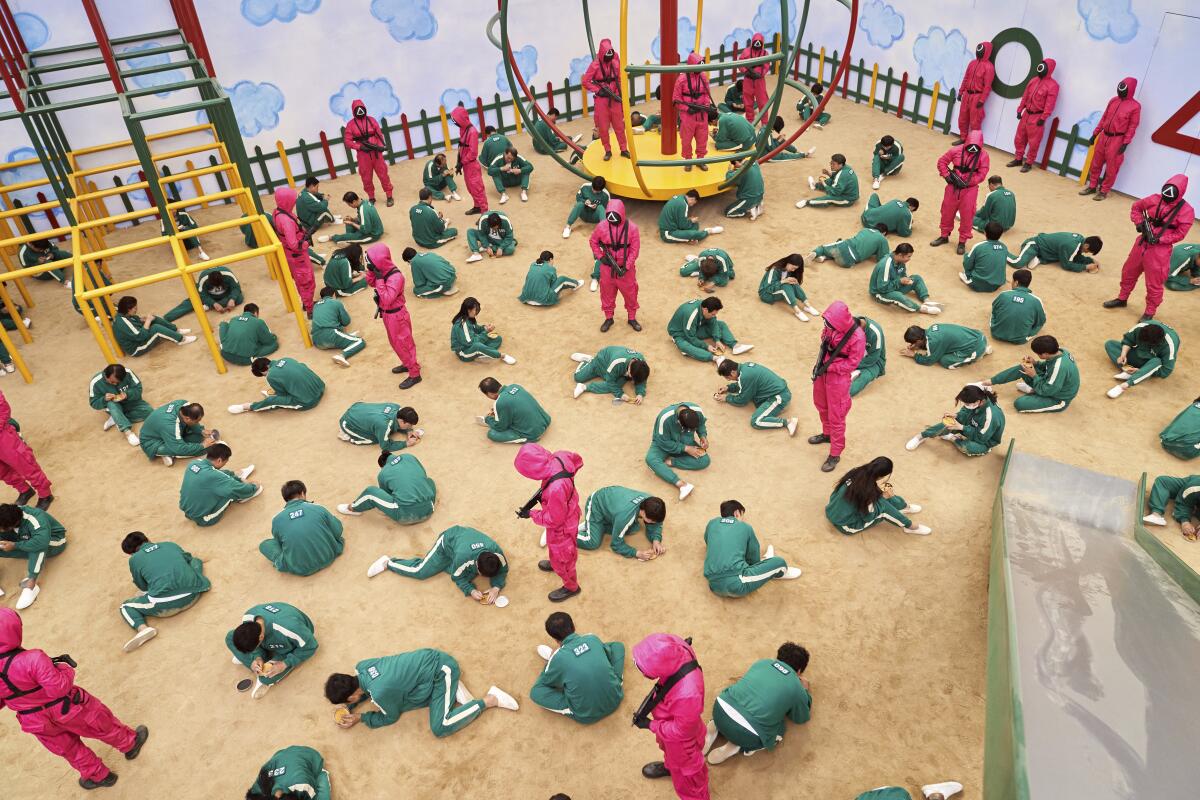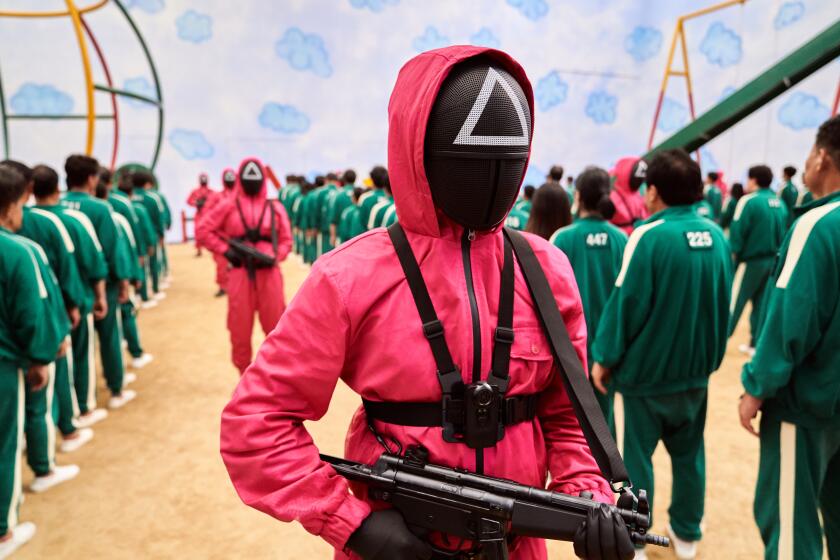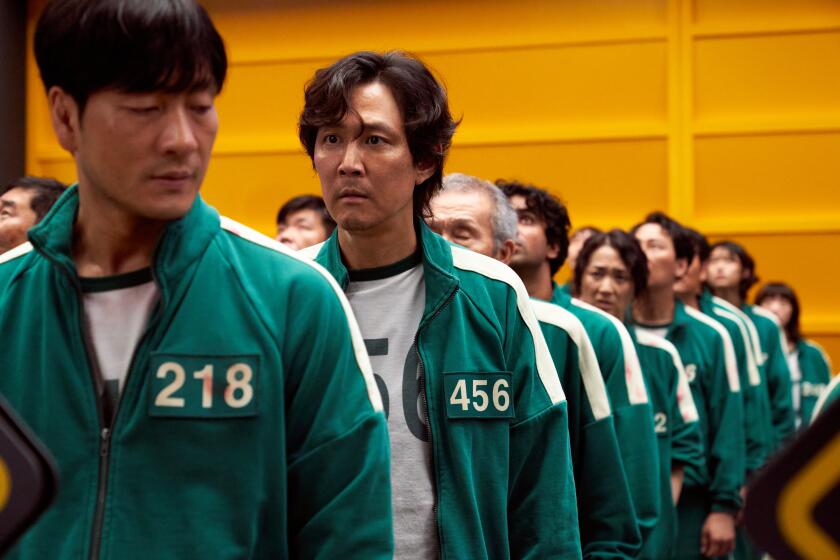How much did MrBeast’s ‘Squid Game’ remake on YouTube cost? We did the math

Not everything has to be as feel-good as a Marvel superhero movie to become a global cultural hit. When “Squid Game” first splashed across Netflix viewers’ screens in September, the Korean-language show’s fictional story started with 456 desperate, heavily indebted contestants being invited to participate in a mysterious competition that takes place on a private island. The winner of a series of children’s games gets a massive cash prize. The losers face death as wealthy VIPs watch.
This morbid creative formula was a winning one for Netflix. Part “Hunger Games,” part “Battle Royale” and part “Parasite,” the nine-episode project featured a magnetic cast, plus just enough demented bloodshed to attract viewers who might be less interested in the show’s unsubtle critique of capitalism. Netflix said 142 million households watched the show in its first four weeks — the largest launch in the service’s history.
But if you’ve spent time recently on one of Netflix’s biggest screen-time competitors — YouTube — you may have seen a very different version of “Squid Game” crawling to the top of the charts, one created by YouTube’s most watched creator of 2021: MrBeast, whose real name is Jimmy Donaldson.
As of Thursday, the MrBeast video “$456,000 Squid Game In Real Life!,” which was uploaded on Nov. 24, has become Donaldson’s most popular video, with 158.2 million views. Hosted by Donaldson, the clip features 456 real-life contestants playing the same games as in the fictional “Squid Game” on sets that mimic those on the Netflix show, and also for a cash prize, but without all the murder.
If you aren’t familiar with MrBeast videos — or if you don’t know any YouTube-watching kids who can explain his deal to you — the titles of Donaldson’s other most popular videos alone should give a sense of his stunts-and-cash formula: “I Spent 50 Hours In Solitary Confinement,” “I Put 100 Million Orbeez In My Friend’s Backyard,” “Anything You Can Fit In The Circle I’ll Pay For” and “Press This Button To Win $100,000!”

Given his “Squid Game” video’s popularity, it’s worth exploring what, exactly, is so appealing to viewers about the MrBeast method. Although the original “Squid Game” and the derivative MrBeast version are more or less squatting on the same intellectual property, comparisons of the two are more notable for what their differences say about their respective places in the global entertainment industry.
“Squid Game” creator Hwang Dong-hyuk appeared to approve of the video during a recent red-carpet interview at the 2021 Gotham Awards, saying, “I watched some of it. I loved it, and it helped me to promote the show, too, so I want more people to do it.” (Netflix did not respond to a request for comment.)
It famously took a decade for Hwang to find a studio willing to create his concept for “Squid Game,” which was inspired in part by a failed strike to avert layoffs at the auto manufacturer SsangYong after the 2008 global financial crisis. The show is primarily focused on the story of contestant Seong Gi-hun (played by actor Lee Jung-jae), a laid-off trade unionist who had fallen into debt after the strike and remained traumatized by the police violence that ended the factory sit-in. The shadowy power brokers and the low-level guards who run the game spend most of the show faceless and are largely secondary to the main plot anyway; it’s a story in which the losers of class warfare are the stars. Netflix has said the show, which has nine separate episodes that are mostly an hour long, reportedly cost $21.4 million to produce.
The popularity of “Squid Game” is inseparable from South Korea’s very real crisis of mounting household debt, gaping inequality and a weak social safety net.
Through a representative, Donaldson declined an interview request about his YouTube riff on “Squid Game” as MrBeast. “I remember when I’d be excited if a video broke 10 views lmao,” Donaldson, 23, said in a tweet on Nov. 25 after it became clear the video was on its way to becoming a hit. “I’m literally living the life 13 year old me would dream of every night and I’m super grateful.”
Donaldson’s version of “Squid Game” has no such pretensions toward high-minded social commentary, instead compressing the Netflix show’s games into the MrBeast house style of upbeat stunt philanthropy that Donaldson has honed in the last couple of years. MrBeast clips usually clock in at between 10 to 20 minutes, which, as far as length goes, makes the 26-minute “Squid Game” video a sort of Scorsese-esque entry in the MrBeast oeuvre. During the video, Donaldson says that its production cost $3.5 million.
Doing napkin math, that would mean Netflix spent about $43,500 for each screen-time minute of “Squid Game,” while Donaldson’s production spent about $134,600 for each minute of his YouTube adaptation. The pair also have divergent funding models: While Netflix’s funding is driven by paid viewer subscriptions, Donaldson says his own free-to-watch production was funded in part by the outside video game company that he promotes heavily during the competition. The MrBeast production is, essentially, an elaborate ad.
The MrBeast video also skips the Netflix show’s exposition about the contestants and goes straight to the action: “I re-created every single set from ‘Squid Game’ in real life, and whichever one of these 456 people survives the longest wins $456,000,” Donaldson says to start the video, eschewing the iconic masks that obscured the faces of the Netflix show’s villains. He is, after all, the real star here. Within 18 seconds of the video starting, contestants are competing in the first game — red light, green light — in a cavernous warehouse-like space constructed to look like an eerie playground from the show.
As Donaldson’s video sprints ahead, its narrative efficiency and rapid-cut editing betray a completely different stylistic influence on the MrBeast brand: American reality television.
Says reality TV editor Katherine Griffin, “$3.5 million dollars is a pretty decent amount of money to make one episode of a television show, which is essentially what this is.” Griffin has worked on shows including “The Amazing Race” and “RuPaul’s Drag Race All Stars” and watched the MrBeast video with an editor’s eye at The Times’ request.
‘Squid Game’ has conquered the world, according to the streamer. Our TV critic explains what it is — and why you might like to catch up.
“One of the ways it feels like reality television is it’s highly edited, it’s super fast-paced, they keep it moving and keep it exciting by changing the music every 10 seconds,” says Griffin. “It’s visually very exciting.”
Griffin spotted reality TV editing techniques like “the fun little sound effects and fun little graphics, like ‘pow pow,’ the way they have the subtitles when things are moving fast, or the fun little instant replay” when something dramatic happens. The clip also uses what’s called “on the fly” interviews with contestants as the action is happening, and edited each round of tug of war to be shorter than the one before, which is also common in contest shows to keep the action flowing. At one point, the video briefly quotes interview outtakes of contestants talking about what they would do with the prize money.
Griffin’s conclusion: “Not only is it professionally edited, but look at the production design, the copying of all of these sets. ... It’s made to look like this fun little thing that people can stream on the bus or whatever, but it was a huge expense to make this video, and a lot of professional people are working on it.”
But who? “I have no idea how many editors are on it, because there are no credits,” Griffin says. “I don’t know if YouTube videos do that, but it seems like they ought to, because somebody should get credit for it. If this were a professional reality show on one of the networks, there would be anywhere between two to five editors working on this.”
Some of the postproduction work, separate from that of Donaldson’s in-house editing team, was performed by SoKrispyMedia, a visual-effects firm that released its own viral behind-the-scenes video of the labor-intensive work it took to complete 350 shots in MrBeast’s “Squid Game” video. Some sets were painted and constructed by hand like the show’s, but other backdrops were created through CGI, like the glass bridge and tug of war games, which are made to look like the contestants are on platforms hundreds of feet in the air.
One of the contestants, another YouTube creator who goes by the handle NightFoxx, said in a video diary that filming in North Carolina was supposed to take two days but got extended by a day because of technical challenges on set with the red light, green light game. “Dang, there was a lot of it,” NightFoxx said of the CGI, which included the fake gunshots that hit contestants when they lost. “The editing in this video is insane. ... MrBeast will do whatever it takes to make a good video.”
For Griffin, the popularity of the MrBeast video and its underlying craftwork reminded her of how the entertainment industry initially looked down at reality television as a lesser creative form. Even today, “It’s rare you’ll find someone who will just admit they like reality television. It’s always a ‘guilty pleasure,’“ Griffin says. “There is this perception that it’s, I don’t know, easier to create or somehow it doesn’t take as much skill.”
She cautions against this sort of thinking when trying to assess why a new creative medium is becoming increasingly successful. “Reality television was thought of as new media, but it’s no longer new media,” Griffin says. “It takes up half of everyone’s television sets.”
And the future seems to look more like MrBeast’s grinning face, streaming on a million smartphones, every day.
More to Read
The biggest entertainment stories
Get our big stories about Hollywood, film, television, music, arts, culture and more right in your inbox as soon as they publish.
You may occasionally receive promotional content from the Los Angeles Times.












